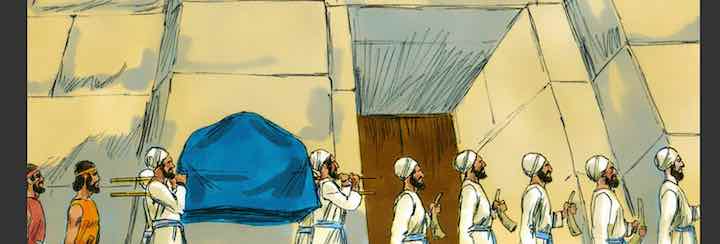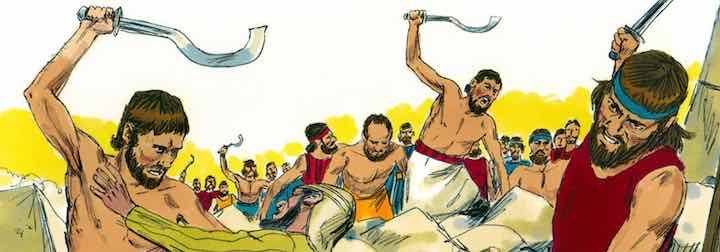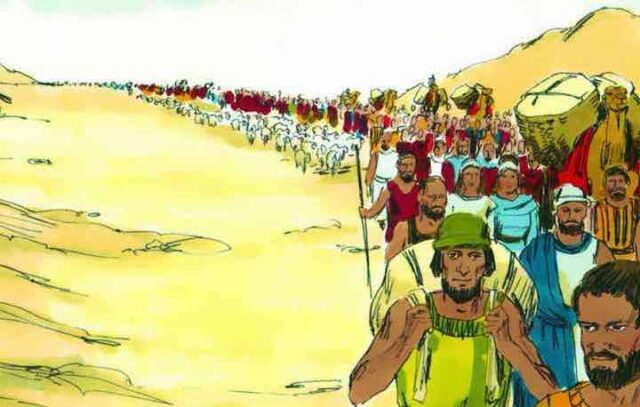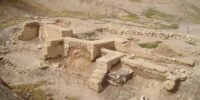I’m starting a series of posts examining some of the most vexed questions about the Old Testament of the Bible.
Can we believe all the miracles …. or any of them? Did God really behave that way? Does archaeology really support the Bible story, or prove it didn’t happen?
Today I’m examining accounts in the middle of the Old Testament period which raise some of the hardest questions of all.
- Did two million people escape Egypt, walk across the Sinai desert and invade the land of Canaan to establish the state of Israel?
- Did God order murder, genocide and destruction along the way?
- Was this part of Israel’s history really as bloody and destructive as it is told in the pages of the Bible>
How can we know what’s true?
In examining these questions, how can I know what actually occurred and what didn’t?
The reality is that no-one can know for sure. The best we can do is to understand what most likely happened. And there are four major factors that will lead us to a conclusion.
The Bible
The Bible contains a record of events in the Middle East, from the viewpoint of the nation of Israel. For those who believe that the Bible is always reliable in its history, there is no further question. But others say its religious origins rule it out as a source because the writers had a biased viewpoint.
However historians say all ancient documents had a viewpoint, whether religious or political or whatever, and the historians’ task is to glean from each what they can. For them, the Bible is simply another useful source.
Other ancient documents
Many other ancient texts have been preserved and discovered. They may be on papyrus, clay or stone tablets, on monuments or in tombs. Egyptian texts (mostly royal, government or religious texts) are generally more prevalent than other sources because of the long term stability of government and the better preservation of papyrus due to the dry conditions.
Archaeology
The remains of cities and buildings, monuments, tombs and artefacts such as coins, earthenware, etc, can all help verify events and a range of dates.
Assumptions
Each of us brings assumptions to what we are willing to believe and the conclusions we draw. Some of us trust science more than others do. Some require more evidence than others do. Historians are no exception although their discipline aims to reduce the impact of these. Some Old Testament historians are “minimalists” who believe very little of the early Old Testament has a historical basis, while “maximalists” tend to trust the text unless there is good reason not to.
In writing these posts, I have tried to read both sides of the questions and find a reasonable consensus somewhere between the minimalsts and maximalists.
Moses and the great escape
The book of Exodus tells the story of a bunch of 2 million slaves escaping Egypt after God sends a series of calamities on Egypt culminating in the deaths of every first born son. God makes a path across the Red Sea for them to escape, then the waves rush back in to drown the pursuing Egyptian army. The miracles continue with the miraculous provision of food and water in the desert, as God leads them to the “Promised Land” of Canaan.
Historically, there are several reasons why most historians doubt some or most of the details in this story:
The numbers seem grossly exaggerated
- The population of Egypt at that time is estimated to have been about 2 million. It is hard to believe that two million Israelites could have been enslaved by them. And such a huge loss of labour would have had a devastating effect on the Egyptian economy.
- Imagine how long a column of 2 million people would have made across the desert. So long that the first would have completed the day’s journey before the last ones started. It seems impossible.
- Archaeology suggests the population of Canaan, both before and after the supposed invasion, was something like a hundred thousand. Two million could never have lived there.
Where does it fit in history?
There is no agreement on when the exodus could have happened. There is no clear time in Egyptian history for such an event, and the archaeology of Canaan (see below) doesn’t give a consistent date. The migration of 2 million warlike people would have had far more ramifications than can be found in the historical and archaeological record.
In addition, Egypt controlled Canaan at the time most maximalists believe the exodus happened, so in travelling from Egypt to Canaan, the Israelites would not be escaping Egyptian power.
Does God really act like that?
The exodus story is full of amazing miracles (parting the Red Sea, miraculous provision of food and water, God leading them by a pillar of fire or cloud) and taking of human life (killing the first born sons and drowning the Egyptian army) that even many Christians and Jews doubt these aspects.
But there are reasons to believe something occurred
There is a slowly growing view that an exodus did indeed take place, but in much smaller numbers and without some of the divine interventions. DNA evidence suggests that the majority of the later Israelite nation was composed of Canaanites already living there, but the Levites who formed the priestly clan had a totally different origin.
Names and practices (e.g. the design of the portable temple known as the tabernacle) support this conclusion. A group (or maybe several groups) of monotheistic slaves did perhaps emigrate from Egypt to Canaan, bringing monotheism and religious practices with them. On this hypothesis, the stories were embellished in the re-telling to reach what we have today, which is sometimes described as “mythicised history”.
Read a fuller discussion of this in Did Moses really lead 2 million people across the Red Sea and into Canaan?

Joshua and the walls of Jericho
40 years after Moses led the Israelites out of Egypt, Moses has died and Joshua is in command. The Israelites are about to enter the promised land at last. But standing in the way was the ancient fortified city of Jericho.
The Bible describes God commanding the Israelites to march around the city each day, and seven times on the seventh day. The walls collapse and, following God’s instructions, the Israelites enter the city, kill every person and animal except for one favoured family, and destroy the city by fire.
It is a fantastic and bloody story. Yet some of it seems to have happened. Sometime in the period 1,600 to 1,300 BCE, Jericho’s mud brick walls did collapse outwards (the opposite to being breached by a battering ram that would push them inwards). The city was burnt, even precious grain, as in the Bible story.
The Bible seems to preserve memory of a clear historical event.
But identifying this destruction with Joshua is more problematic. Various methods of dating point to Jericho being sacked around 1,600-1,500 BCE, while the best historical evidence suggests that if any exodus actually occurred, it was later, more like about 1,250 BCE.
But the question is more complicated than that. Many scholars (mainly maximalists) argue for a date for both the exodus and the sacking of Jericho about 1,400 BCE.
This matter is still not fully resolved. It appears more likely that Joshua didn’t cause the destruction that occured, but it isn’t impossible. Whether the walls fell due to an earthquake, and attack or the command of God is not a question historians can answer. And whether God would command such killing is up to you to decide – but I discuss it below.
Read more about Jericho in Did the walls of Jericho really fall down?

Conquering Canaan
The Old Testament book of Joshua describes Joshua and his army entering Canaan after they have sacked Jericho, and attacking city after city. Ai, Makkedah, Libnah, Lachish, Eglon, Hebron, Debir & Hazor were all captured and their entire inhabitants killed, supposedly as commanded by God. All in all, 31 kings were defeated and killed. Gibeon survived because its inhabitants tricked the Israelites into a treaty.
There are two problems with this account.
Not all the cities
While Joshua chapters 1 to 12 describe this mayhem and total annihilation, chapters 13-24 make clear that many of these cities weren’t wiped out – at least nine that I have counted remained with Canaanites and sometimes Israelites living in them. It seems that the total destruction narrative is an idealised or exaggerated picture, presumably for political or propaganda purposes.
The archaeology
Many of these sites have been identified and excavated. It turns out that while many Canaanite cities were destroyed in warfare in the late second century BCE, the evidence suggests it was often not the Israelites who were responsible. Many cities don’t appear to have been destroyed around the time of Joshua. Ai was destroyed almost a millennium earlier. Jerusalem and Megiddo were not captured until much later. It is doubtful if Gibeon, Arad and Heshbon even existed at the time of Joshua.
Understanding the book of Joshua
It therefore seems more likely that the incoming Israelites assimilated into the local population and gradually came to dominate them culturally and religiously. Fighting and violence were common at that time, but the outcomes were much less clearcut. It seems that much of the violence in the book of Joshua didn’t actually occur.
The book of Joshua reflects this. Chapters 1-12 claim that Israel totally conquered and occupied the land, but chapters 13-24 show a much more gradual and incomplete change. Later editors and compilers of the Jewish scriptures seemed quite happy to leave both accounts in the book.
Read about the conquest in more detail in Did God really order the slaughter of the Canaanites?

What can we learn about God and the Bible?
These conclusions are disturbing to Christians who believe the Bible is God’s word, and therefore totally truthful in all its history.
But there’s another way to look at it. Christian scholar, John Walton, argues that we need first to understand the intentions of the writers, editors and those who passed the story down orally. (It’s obvious really, but easy to forget when approaching the Bible.) We understand a parable differently to a letter.
He explains that in ancient conquest accounts “exaggerating the magnitude of the victory and the scale of the casualties” was characterisitc of the genre, and readers wouldn’t have considered such “rhetorical hyperbole” as deceptive. The purpose of the accounts are not so much historical, but interpreting the events.
Both apologists and critics miss these subtleties and so misunderstand the texts.
If this is true, there are other positives. If the Old Testament account is accurate history, God killed thousands of firtborn Egyptian children who had done nothing deserving of death, caused the Egyptian army to drown, and commanded the massacre of all the inhabitants of city after city – not just fighting men but babies, pregnant women, the disabled, grandfathers, etc. And not just via peaceful euthanasia, but put to the sword in a bloody and violent reign of terror.
If committed today, these would be war crimes, genocide.
I can’t think that a loving God could do that.
Some Christians try to justify it by saying God’s purposes required just judgement and the removal of threats to God’s plan of salvation. I think they are blaspheming God’s character for the sake of defending a dogmatic view of the Bible’s inerrancy. There is little justice in such killings.
Of course we know they were violent times, and such killing and ethnic cleansing did occur. But I still find it impossible to believe that God approved of them and commanded them.
So both historically and ethically, I prefer to believe in a perfect God and “imperfect” and culturally relevant scriptures rather than perfect scriptures and an imperfect God.
I’ll look at this more in a later post, but I believe it fits better with history, archaeology and the loving character of God to say that the scriptures God has given us are human documents reflecting the beliefs at the time, and showing how God gradually moved people from this ethic of violence to an ethic of love.
What do we make of Moses & Joshua?
So it seems best to understand these stories as the majority of historians apparently do – mythicised history told to justify Jewish beliefs in the land being promised to them by God.
There is flexibility in how much we believe is historical and how much is legendary, but I believe the evidence shows the stories are a little of both. I think it likely that a man named Moses really did lead a group of slaves out of Egypt. Perhaps a man named Joshua (recognising that the name Joshua means “Yahweh is salvation”, and so may be a name given later) did lead the same group into Canaan. There was fighting, and Jericho’s walls did fall down. But numbers and victories have been exaggerated, and much of the stories have been talked up and written up to strengthen the Israelites’ claim to the land.
This doesn’t change the core of what I believe as a Christian. The New Testament books are quite different literary genres and the historical evidence for Jesus is very good.
Graphics: Free Bible Images.




